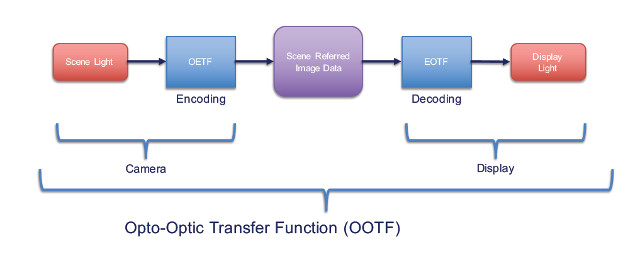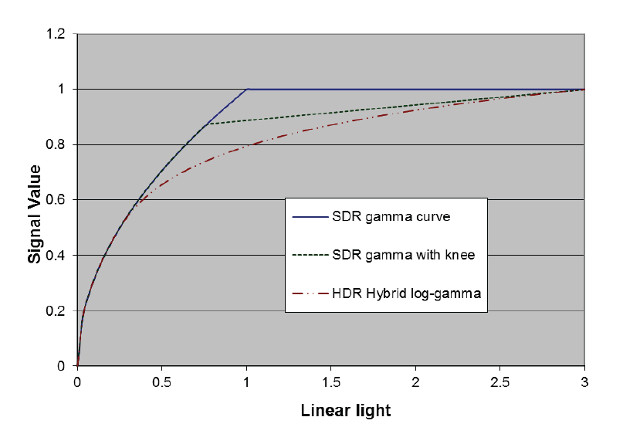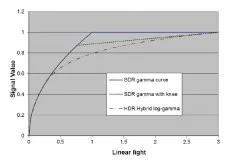A paper by Tim Borer and Andrew Cotton from the BBC Research & Development team at the SMPTE fall conference shed more light on what Hybrid Log Gamma (HLG) is and why it may be better suited to realtime or live broadcast than alternative transforms like the Perceptual Quantizer (PQ) curve. (BBC Approach to HDR Has Advantages for Broadcasters) This latter, may be best suited for non-realtime or file-based applications. HLG has been standardized as ARIB STD-B67 and is being considered by SMPTE as well.
The HLG curve is an Opto-Electronic Transfer Function (OETF). It is a curve that is applied to the captured HDR sensor signals that reduces the bit depth and that better matches the visual perception of people. The Electro-Optic Transfer (EOTF) curve is applied at the display. It is designed to adjust the highlights, shadows and midtones to try to replicate what the scene looked like. These are called gamma curves as they follow a power law. The Opto-Optical Transfer Function (OOTF) or system gamma describes the end to end linearity of the imaging system.

If the consumer has TV and a viewing ambient matches the mastering environment, then the EOTF would be the inverse of the OETF (PQ curve). But end user display brightness and viewing environments rarely match the mastering set up. That means a different EOTF is needed at the display to maintain “rendering intent” so the image is perceptually similar to the master. This makes the lens-to-display system non-linear.
Having the right display, and therefore system gamma, is dependent upon the display brightness and viewing environment. If the gamma exponent is too low the image looks washed out. If too high, the image looks dark. Research suggests that a system gamma of 1.0, 1.25 and 1.5 should be used for light, dim and dark surrounding environments.
You may have noticed a big flaw in this argument. The environment surrounding the end user is not known. The environment must be assumed for SDR production, but with HDR, we have the ability to change the display gamma for a more optimal viewing environment. In practice, SDR system gamma is about 1.25 and the cinema system gamma about 1.55 to 1.8. System gamma operates on the luminance to provide the tone mapping – not the color volume mapping.
Current video cameras can capture more dynamic range than is conveyed in the SDR production pipeline. The conventional SDR gamma curve, shown in the figure below, clips the normalized light above 1. That means higher lumen values all appear at the same brightness so there is no detail visible in the bright segments.
To address this, some cameras can add a “knee” to the SDR gamma curve to allow some of these highlights to be captured with some detail. The HLG gamma curve changes the shape from linear to logarithmic for these higher luminance values, better matching human perception and minimizing any banding or contouring artifacts.

In addition to the new OETF curve at the camera, HLG also does something a little different at the display. For example, the SDR EOTF, Rec 1886, applies a black offset to the video signal. This is done to help raise the black details above the black level of the display for better viewing. Rec 1886 does this to the non-linear, gamma-corrected video signal. But this technique increases banding and reduces dynamic range.
HLG applies the black level video offset to linear, or “scene referred” light, i.e. before the application of the gamma correction. The result is a dramatic reduction in banding in the dark areas and the preservation of dynamic range (6 F-stops).
A technique called “Weber fractions” is used to see how the display (EOTF) gamma curve will perform in terms of banding or contouring. The SMPTE ST 2084 Perceptual Quantizer or PQ curve with 10-bits performs very well with minimally perceptible banding at low luminance levels (the 12-bit version is preferred to eliminate any banding). The HLG curve performs almost as well as the 10-bit PQ curve and significantly better than the SDR ITU-R Rec 1886 display gamma curve where banding will be evident below 20 nits.
Borer also listed the broadcaster requirements for a new HDR OETF.
- Easy migration from SDR to HDR Production – Implies compatibility with existing SDR infrastructure and displays. Cameras can be upgraded to accept the HLG OETF.
- Little or no impact on existing workflows and operational practices – Implies minimal use of metadata. HLG signals can be mixed, resized and compressed using conventional tools. SDR displays show the HLG HDR signal, with HDR displays needed only for quality control.
- A single asset to deliver to both HDR and SDR platforms – Implies automatic HDR to SDR “downconversion”. HLG compatible with HEVC Main 10 profile.
- A bitrate efficient method to deliver to both HDR and SDR receivers – Implies an HDR “backwards compatible” Bitstream. 10 bit pipeline needed but with 10% bandwidth increase vs, 8-bit. HLG compatible with 10-bit SDR signals.
The HLG solution meets these requirements, concluded Borer.

